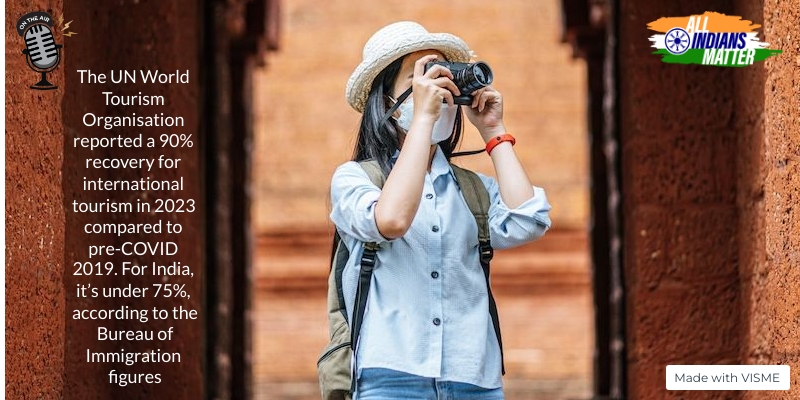Ashraf Engineer
May 11, 2024
EPISODE TRANSCRIPT
Hello and welcome to All Indians Matter. I am Ashraf Engineer.
In March, a Brazilian woman on a motorcycle holiday with her Spanish husband was gangraped in Jharkhand’s Dumka district. Later, she shared her trauma on social media. The outrage that followed highlighted the lack of safety many women tourists feel in India. Some aborted their trips here while others vowed never to visit. The lack of safety for women visitors is shameful, of course, and it has a real economic impact too. The number of foreign tourist arrivals into India is dropping and the negative news is not helping. From 10.93 million foreign arrivals, or FTAs, in 2019, FTAs naturally fell sharply during the COVID-19 pandemic. But, despite it being years since the lockdown was lifted, the numbers aren’t recovering. In 2022, India had only 6.44 million FTAs and 8.16 million for 2023 till November that year. Meanwhile, global tourism numbers have bounced back. The UN World Tourism Organisation reported a nearly 90% recovery for international tourism in 2023 compared to 2019. For India, it’s under 75%, according to the Bureau of Immigration figures. At least part of this is because the country is perceived to be less than safe for women.
SIGNATURE TUNE
Several people, including women travel influencers, shared their concerns on social media over safety. Travel influencer Ankita Kumar posted about the Spanish lady’s trauma: “We have failed her as a country, we need to make sure justice is served.” Another post read: “So ashamed and disappointed I am.”
Travel industry leaders urged the local government to prosecute those responsible. They also said that an effective crisis management response is needed to reassure women travellers that comprehensive safety measures are being implemented.
The Jharkhand sexual assault is only the latest horrifying example. There have been so many other disturbing incidents. In 2013, a Swiss woman on a cycling trip with her husband was raped in Madhya Pradesh’s Datia town. More recently, a video of a man harassing a South Korean vlogger in Maharashtra went viral. In 2022, a British woman was raped at Goa’s Arambol beach. In 2016, a German woman was raped by a rickshaw driver in Delhi. In 2018, a Latvian tourist was raped and decapitated. It’s a seemingly endless list.
Such experiences have led to several foreign governments issuing warnings about travel to India. The perception is that you need nerves of steel, lots of security and tons of luck to be a foreign woman travelling through India.
Another factor giving women pause, say experts tracking the travel industry, is India’s fall in democracy rankings and the widening communal fissures. The country is not seen as welcoming by many now.
The experience, however, seems to vary by region with women tourists reporting higher levels of safety in South India.
The government says it has responded with a series of steps to combat the negative perception. These include tourism police forces, so-called pink police units for women’s safety, a women’s helpline number and tourism helplines in several states.
However, it seems to be accompanied by a high level of negative sensitivity. Recently, an American journalist highlighted instances of sexual harassment of tourists in India. Rekha Sharma, chairperson of the National Commission of Women, reacted sharply and immaturely, accusing him of defaming the country. But the view expressed by the journalist is not new and has been echoed in the past by many. The international media has often pointed to the danger felt by women tourists along with the quality of the air and the filth strewn everywhere. Some even offer ‘survival guides’ for navigating India and travel sites log tons of negative reviews and complaints.
Again, it’s the safety concerns for women that abound in travel advisories. A Canadian advisory said: “Reports of rape and assault against foreign women have increased.” The US, meanwhile, advised women to not travel alone. Australia warned: “Women may face higher levels of verbal and physical harassment or sexual assault.”
All of this has a corrosive effect on Brand India. This at a time when India is trying to make a bigger mark on the global stage and attract foreign investment. However, safety concerns, combined with those over pollution and communal divisions, won’t help.
Tourism industry associations highlighted the need for tour operators to educate women travellers about destinations on their itinerary. They also said cultural awareness must begin early in India and highlighted the role of schools. Schools, they said, must educate students about respect for women and the law.
While that is the situation when it comes to safety of women travellers, I wanted to also speak about how pollution is another major reason for the fall in tourist arrivals.
This is not new either. In 2017, an Assocham report said Delhi would drop off the map of international tourists. By 2019, the prediction had come true. Bloomberg reported that business travellers and tourists were cancelling or rescheduling trips to Delhi due to the air quality. That situation has not improved.
According to the World Air Quality Report by Swiss company IQ Air, 39 of the world’s 50 most polluted cities are in India. Most of them are in the north but major cities like Mumbai and Kolkata frequently feature in this ranking.
Let’s look also at Mercer’s 2023 Quality of Living City ranking, which takes into account air quality, water and sanitation. Of the 240 cities across the world, the top ranked one in India was Hyderabad at a dismal 154. Pune, Chennai and Mumbai followed a few rungs below. Delhi was at a low 172.
The link between pollution and falling tourist numbers is well known and documented. A 2016 survey published in the ‘Journal of Sustainable Tourism’ showed that China’s air pollution contributed to a decline in inbound tourism between 2001 and 2013. During this period, China was home to 20 of the world’s 30 most polluted cities.
Brunei was another example. In 1997 and 1998, the extreme haze from Indonesian forest fires enveloped the entire region. In a 2000 study, the journal ‘Economic Analysis and Policy’ estimated a loss of 1 to 8 million Brunei dollars to the country’s tourism industry due to the pollution.
In 2021, climate tech company Blue Sky Analytics released a study conducted between October 2019 and 2020 documenting the drop in tourists in commercial and tourist hubs in Delhi. The drop was due to the air pollution. It documented a 40% drop in online enquiries when air pollution levels were double the annual average.
It’s no wonder that India comes with a ‘hardship allowance’ for staffers in some embassies, yet another indicator of how the country is perceived globally.
I started the episode talking about safety of women tourists in India and, while I segued to pollution, I don’t want to lose sight of the former. Safety is the primary concern of any visitor anywhere. India, unfortunately, has been a society in which women have always been treated badly in every sphere – from social status to work. And it remains one of the most dangerous countries for women in the world. If we are to be seen as a civilised place, one that offers a quality experience to tourists and therefore reaps the economic benefits of it, a lot needs to change.
Thank you all for listening. Please visit allindiansmatter.in for more columns and audio podcasts. You can follow me on Twitter at @AshrafEngineer and @AllIndiansCount. Search for the All Indians Matter page on Facebook. On Instagram, the handle is @AllIndiansMatter. Email me at editor@allindiansmatter.in. Catch you again soon.






